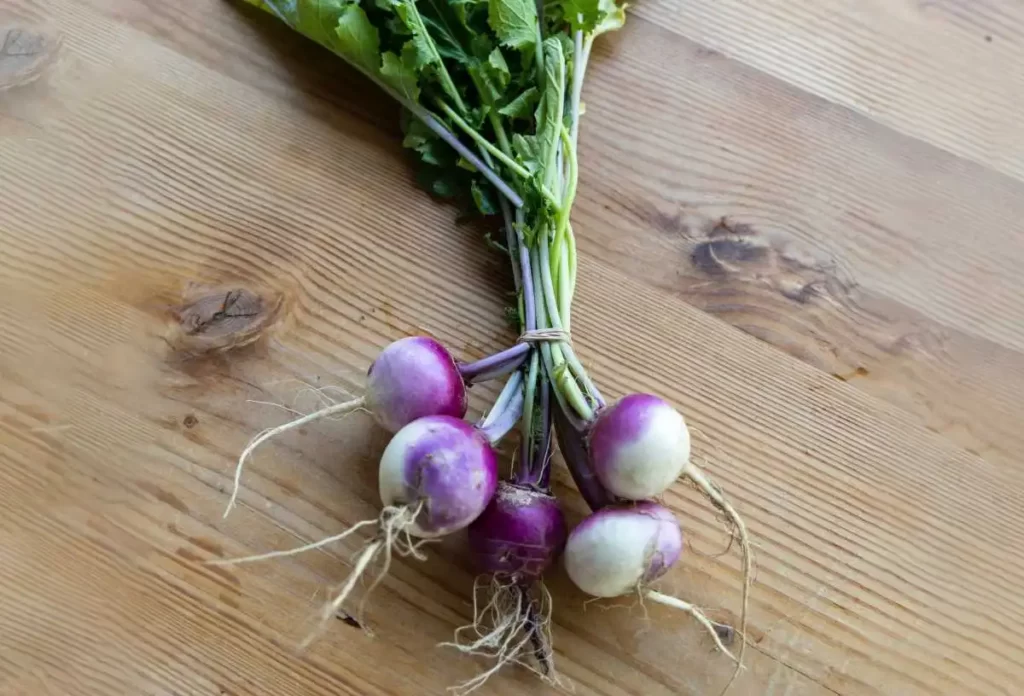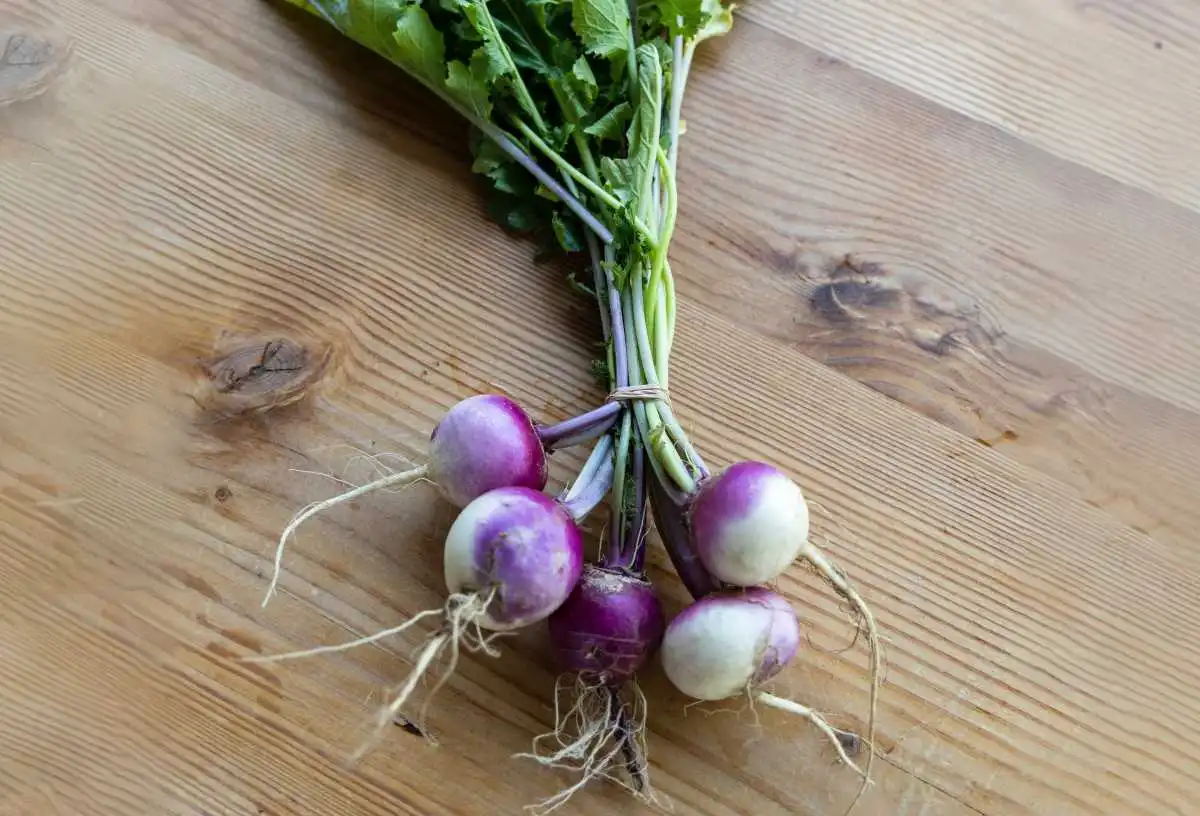Turnips, often overshadowed by their more popular vegetable counterparts, possess a unique flavor profile that deserves exploration.
They belong to the Brassicaceae family, sharing roots with cruciferous vegetables like cabbage, broccoli, and radishes.
With a rich history dating back to ancient times and a versatile culinary presence, turnips have intrigued taste buds across various cultures.
In this detailed guide, we delve into the multifaceted taste of turnips, exploring their flavors, textures, culinary uses, and more.

Table of Contents
What are Turnips?
Before diving into the taste of turnips, it’s essential to understand their characteristics.
Turnips are root vegetables featuring a round, bulbous shape with edible roots and leafy greens.
They come in various hues, from creamy white to purple-tinged and can vary in size, with some smaller varieties and others more substantial in size.
This vegetable boasts versatility in the kitchen, as both its roots and greens are edible.
Turnip roots are often used in dishes like soups, stews, roasts, and mashed preparations.
Meanwhile, the greens, with a taste reminiscent of mustard or spinach, can be cooked similarly to other leafy greens or used in salads and stir-fries.
What Does Turnip Taste Like?
Flavor Profile
Describing the taste of turnips poses an intriguing challenge due to its multifaceted flavor profile.
The root of a turnip offers a blend of sweet, peppery, and slightly bitter notes.
When raw, it provides a crisp texture with a mildly spicy taste, akin to a radish but milder.
Cooking turnips alters their taste and texture significantly.
Boiled or roasted turnips tend to soften, bringing out their inherent sweetness while reducing the peppery bite.
The transformation during cooking introduces a delicate sweetness with earthy undertones, making them an excellent addition to various dishes.
Read: What Does Beet Juice Taste Like? Recipe, Benefits, Risks & All.
Textural Qualities
Texture plays a crucial role in defining the taste experience of turnips.
Raw turnips offer a crunchy texture similar to that of a carrot but with a slight denseness.
When cooked, turnips become tender and can range from being slightly firm to almost creamy, depending on the cooking method and duration.
Also Read:
- Tomato: Types, Recipes, Nutrition, Benefits, Risks & More.
- What is a Parsnip? Nutrition, Benefits, Recipes, Side Effects.
Factors Influencing Taste
Several factors contribute to the taste variations in turnips:
Varietal Differences
Different turnip varieties exhibit distinct tastes. Some varieties lean towards a sweeter, milder flavor, while others may have a more pronounced peppery or bitter taste.
Purple-top, Tokyo Cross, and Scarlet Queen are among the diverse turnip cultivars, each offering a unique taste experience.
Growing Conditions
The environment in which turnips grow significantly influences their taste. Factors like soil quality, climate, and cultivation methods can impact their flavor profile.
Turnips grown in rich, well-drained soil often exhibit a sweeter taste compared to those cultivated in less favorable conditions.
Seasonal Variations
The season in which turnips are harvested can also affect their taste.
Generally, turnips harvested in cooler weather tend to have a sweeter taste, as the cold temperatures prompt the conversion of starches into sugars.
However, those harvested in warmer seasons might have a more peppery or bitter edge.
Culinary Uses and Pairings
Turnips’ unique taste and versatility make them a delightful addition to various culinary creations.
Here are some popular ways to incorporate turnips into your meals:
Roasted Turnips
Roasting turnips brings out their natural sweetness while maintaining a pleasant texture.
Toss them in olive oil, season with herbs like thyme or rosemary, and roast until golden brown for a delicious side dish.
Mashed Turnips
Similar to mashed potatoes, mashed turnips offer a lower-carb alternative with a distinct flavor.
Boil or steam turnips until tender, mash them with butter or cream, and season to taste for a comforting side.
Soups and Stews
Turnips contribute depth and flavor to soups and stews.
They absorb the surrounding flavors while adding their unique taste, making them a versatile ingredient in hearty winter dishes.
Pickled Turnips
Pickling turnips preserves their crispness and introduces a tangy flavor.
Combine vinegar, water, salt, and spices of choice in a jar with sliced turnips for a zesty condiment or snack.
Pairing Suggestions
Turnips pair well with various ingredients, enhancing the overall taste of dishes.
They complement meats like pork and beef, and their earthy sweetness balances the flavors of rich dishes.
Additionally, combining turnips with herbs such as thyme, sage, or dill can elevate their taste profile.
Benefits of Turnips
Nutritional Value
Turnips boast an impressive nutritional profile, making them a healthy addition to your diet. They are low in calories but rich in essential nutrients such as:
- Vitamins: Turnips contain vitamins A, C, and K. Vitamin C acts as an antioxidant, supporting the immune system, while vitamin K contributes to bone health and blood clotting.
- Minerals: They provide minerals like potassium, manganese, and calcium. Potassium helps maintain healthy blood pressure levels, while manganese aids in metabolism and bone development.
- Fiber: Turnips are a good source of dietary fiber, promoting digestive health and aiding in weight management by inducing a feeling of fullness.
Antioxidant Properties
The presence of antioxidants in turnips, primarily in the form of vitamin C and other phytonutrients, helps combat oxidative stress.
These antioxidants neutralize harmful free radicals in the body, potentially reducing the risk of chronic diseases and supporting overall health.
Potential Health Benefits
Consuming turnips as part of a balanced diet may offer various health benefits:
- Heart Health: The potassium content in turnips supports heart health by regulating blood pressure and reducing the risk of cardiovascular diseases.
- Digestive Health: The fiber in turnips aids digestion, prevents constipation, and promotes a healthy gut microbiota.
- Bone Health: The combination of vitamin K and calcium contributes to bone strength and may help reduce the risk of osteoporosis.
- Weight Management: Due to their low calorie and high fiber content, turnips can be beneficial for weight management when included in a balanced diet.
Side Effects of Turnips
Goitrogenic Compounds
Turnips, like other cruciferous vegetables, contain goitrogens, naturally occurring substances that can interfere with thyroid function in high amounts.
Goitrogens can potentially interfere with iodine uptake by the thyroid gland and might lead to goiter or affect thyroid hormone production.
However, cooking cruciferous vegetables like turnips can help reduce the goitrogenic compounds’ potency.
Digestive Issues
For some individuals, consuming turnips may lead to digestive discomfort such as gas, bloating, or stomach upset.
This is mainly due to their high fiber content, which can be challenging for some digestive systems to process, especially if consumed in excessive amounts.
Allergies or Sensitivities
While rare, some individuals may have allergies or sensitivities to turnips or other related vegetables from the Brassica genus.
Allergic reactions might manifest as itching, rashes, or gastrointestinal disturbances. If you suspect an allergy, it’s crucial to seek medical advice.
Oxalate Content
Turnips contain oxalates, naturally occurring substances that can crystallize in the body and contribute to kidney stones in susceptible individuals.
People prone to kidney stones may need to moderate their intake of high-oxalate foods like turnips.
Moderation and Precautions
While turnips offer numerous health benefits, it’s important to consume them in moderation, especially for individuals with specific health conditions or sensitivities.
If you have thyroid issues or a history of kidney stones, consult a healthcare professional for personalized dietary advice.
Incorporating turnips into a diverse and balanced diet can contribute to overall health.
Enjoy them in various culinary preparations while being mindful of individual tolerance levels and potential side effects.
As with any food, moderation and awareness of personal health conditions are key to reaping the nutritional benefits of turnips while minimizing any potential risks.
Conclusion
So, what does turnip taste like? The taste of turnips is a complex amalgamation of sweet, peppery, and slightly bitter flavors, with varying textures that evolve depending on how they’re prepared.
Whether raw, roasted, boiled, or pickled, turnips offer a diverse culinary experience.
The interplay of factors like varietal differences, growing conditions, and seasonal variations contributes to the nuanced taste of this humble root vegetable.
Understanding the taste nuances of turnips opens doors to creative culinary experiments.
From roasted side dishes to flavorful stews, turnips bring their unique charm to the table, inviting exploration and innovation in the kitchen.
Embrace the versatility of turnips and savor the delightful flavors they impart to your favorite dishes.

